Mortise sinks for the kitchen: varieties and recommendations for choosing
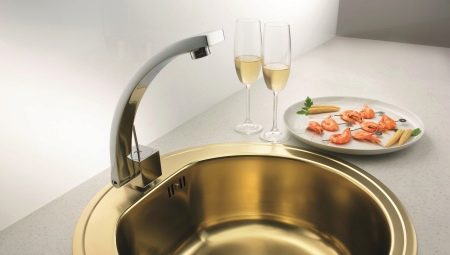
In the process of kitchen renovation, everyone is faced with the problem of choosing convenient, and most importantly, high-quality kitchen furniture and accessories. There are a lot of selection criteria - the size of the room, the style of the interior, the required level of functionality, and more. One of these items is a sink, and before buying, you should decide in advance on the type of sink, size and material from which it is made. Today, specialized stores offer customers a wide range of sinks - from economy class to luxury class. Therefore, everyone will be able to choose an option for themselves that meets all the stated criteria.
There are two types of sinks on the kitchen plumbing market - overhead and mortise. The first requires a separate tabletop or cabinet for installation, on which it is mounted. It is attached to the surface with its edges, so you can do it yourself to install this type of sink. Mortise sinks are mounted on the kitchen surface, in which the necessary armhole is cut out.
It is important to seal well the junction between the countertop and the sink. In recent years, it is mortise sinks that are gaining popularity, which are not only more aesthetic, but also do not require a separate countertop for installation.
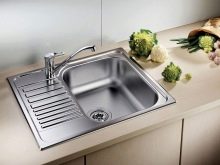
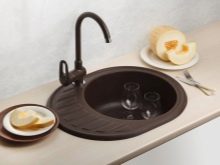
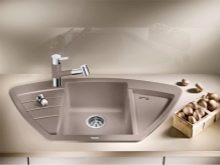
Peculiarities
Despite the fact that many modern housewives have already managed to acquire such a kitchen assistant as a dishwasher, the need for a sink in the kitchen has not disappeared. Yes, the process of washing dishes is greatly facilitated, but no one has canceled washing hands while cooking, as well as various food products - vegetables, fruits, cereals and meat.Going to the bathroom every time is not an option. Today, choosing a sink is just as important in setting up a kitchen as buying a hob or refrigerator.
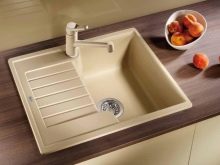
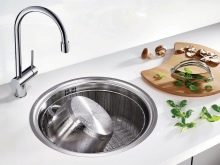
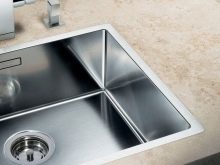
The convenience of recessed sinks makes them more and more popular among kitchen sinks. Such products have a number of advantages that determine the choice of buyers:
- aesthetic appearance will suit any kitchen interior;
- most sinks are made of high-strength metal, which makes them more wear-resistant;
- the small size of the sinks allows you to save more work space on the kitchen countertop;
- the strength of the material from which the mortise shells are made makes it possible to manufacture them in a variety of shapes - oval, square, round and others;
- mortise sinks are resistant to force effects, so they will last much longer than overhead sinks.
The only drawback is the rather problematic installation of a flush sink in the countertop, which most often requires the help of specialists in this field.

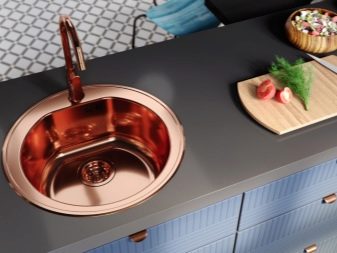
Materials (edit)
Today, a wide variety of materials are used for the production of sinks.
- Ceramic sinks - refractory material makes the product quite strong and durable. They also have an attractive look and fit well into any style of kitchen. The disadvantage is the high cost.



- Stainless steel sinks - such metal products are the most popular, as they combine an attractive price and good quality. Steel shells tolerate temperature surges, mechanical stress well, and the service life of such a product is practically unlimited. You can use any detergent and cleaning agent to clean them. The only drawback is that they are quite noisy, and in order to reduce the noise level, you should choose sinks with dense walls.
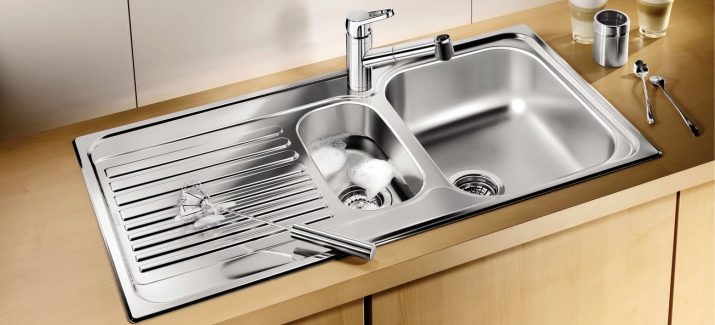
- Bronze or copper sinks... Such products do not tolerate forceful influences, since these materials are naturally soft. During operation, they are easily scratched and oxidized. To avoid this, a protective layer is applied to the surface. Such a sink looks stylish in any interior, however, it is quite problematic to use, so you should think carefully before purchasing it.
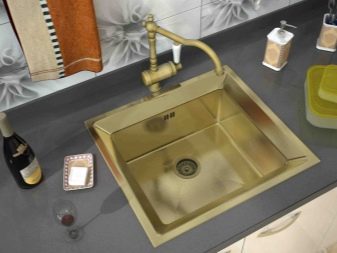
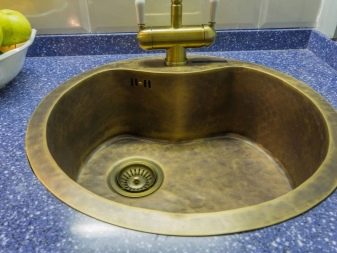
- Natural stone sinks - look rich, but impractical to operate. They have a large mass, do not tolerate temperature fluctuations and contact with food dyes.

- Composite sinks - have a fairly large mass and are highly durable. Sinks made of this material can have a variety of colors and shapes. They are practically silent and tolerate temperature changes well, as well as force effects. Quite easy to clean.
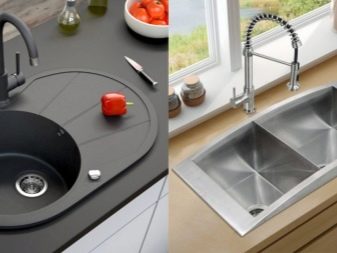
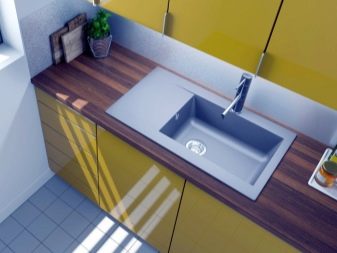
Shapes and sizes
In specialized stores you can find sinks of various shapes and sizes. The bowl of such shells can have the shape of a circle, oval, square, rectangle. Which form to choose depends only on the buyers, since it should not only suit the interior of the room well, but also be practical to use.
Size matters as well as product depth. The optimal sink depth is 20-25 cm, if it is small, water may spill outside the sink when washing dishes... A deep sink can be inconvenient for children, as well as people of short stature.
It is better to choose the diameter of the sink based on the size of the kitchen surface as a whole. For small kitchens, sinks of 35 cm, 38x38 cm, 40 cm, 40x40 cm are suitable.
If the kitchen space allows, then you can choose products with dimensions of 50x60 cm, 50 cm, 50x50 cm, 60x60 cm.And you should also take into account the approximate volume of dirty dishes and the size of the largest pan used for cooking.If small dishes can still be folded next to the sink and washed in turn, then a large saucepan will need to be placed and washed somehow so as not to do this in the bathroom.
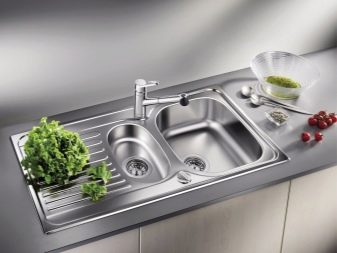
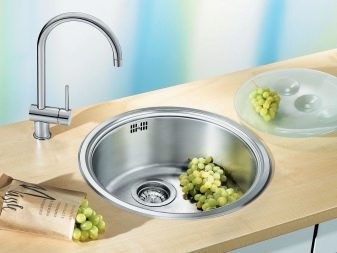
Design options
A flush-mounted kitchen sink is an equally important component of kitchen design. She not only helps to work comfortably in the kitchen, but is also part of the interior. The materials from which the sinks are made allow them to be made in a variety of shapes, sizes, and colors. In addition to the standard metallic color, you can find products in the color of natural stone, beige, white, black and other colors.
The most popular colors are metallic and white, as they will suit almost any style. A black sink looks very stylish in a modern kitchen - hi-tech, minimalism, techno.
In addition to standard sinks, there are products with additional accessories: double bowl, chopping board, wings, waste chopper, detergent container and sponges.
All these additions make the use of the sink even more practical and comfortable. However, the cost of such a model will be an order of magnitude higher than conventional products.

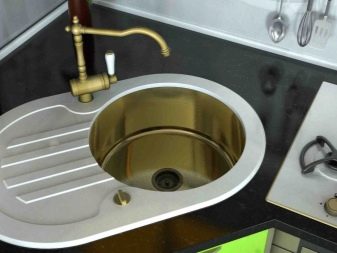
How to choose?
Before you start buying a sink, there are several important points to consider that will help you make the right choice.
First you need to choose the material from which the sink will be made. Products made of enameled steel are an economical option, however, if used improperly, you may encounter the problem of cracks and chips on the surface of the sink. Cast iron sinks covered with enamel - the cost is higher than the previous option, but its disadvantages do not disappear anywhere. The only plus - thanks to the thick walls, the noise of water is practically inaudible.
Natural stone sinks are also impractical to use.
The advantage is that the scratches that appear can be easily sanded down, however, intolerance to high temperatures (over 150 degrees) is a huge disadvantage of such products. Since putting a hot pan in such a sink, you can permanently ruin its surface.
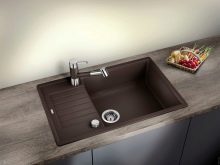
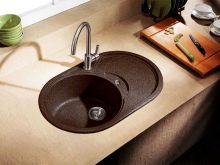

Ceramic products tolerate sudden temperature fluctuations well, and they also do not scratch, and their service life is practically unlimited.
The best option is a stainless steel sink. Its advantages are not inferior to ceramic sinks. Plus, the cost of such a sink is low and meets all its characteristics.
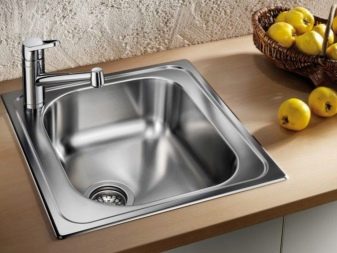
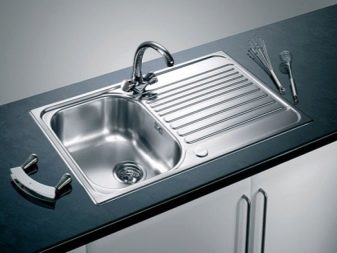
The next selection criterion is size. The optimal depth of the shell is considered to be 20-25 cm. The width depends on the overall size of the entire kitchen work surface. If it is quite large, then the size of the sink can be about 60x50 cm.But for a small kitchen, a sink with a diameter of 35-40 cm would be the best option.
Overflow is required. The size of its grid should be large enough so that excess water can easily drain away.
The presence of the wings allows you to place dishes so that water can drain, as well as hot pots and pans. But it is important to consider that a sink with wings takes up much more work space than a conventional sink.
If the workspace of the countertop allows, you can pick up a sink, consisting of several compartments. In the additional bowl, you can soak dishes, rinse something, or just wash your hands if the main bowl is filled with unwashed dishes.
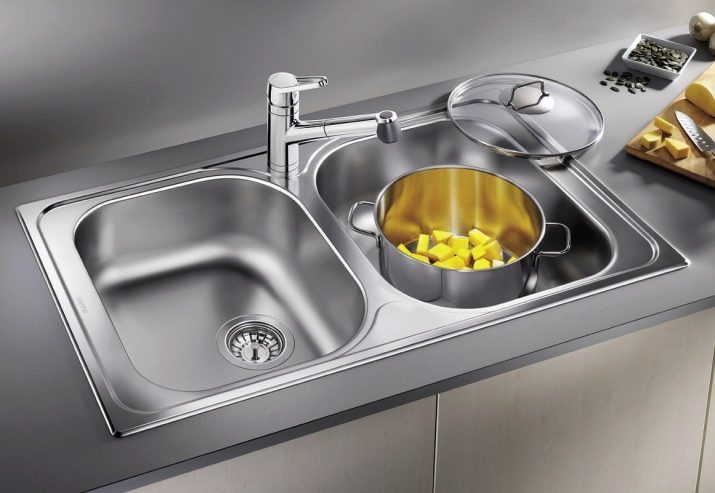
Installation subtleties
Those who decide to install a flush sink on their own should know a few simple rules, who will help you do this without assistance.
- To begin with, you should make a markup of the sink on the working surface, attaching it to the top of the countertop where the sink will be installed.
- Then we step back 1 cm from the drawn markup and draw a second one.
- Using the jigsaw, cut out the marked area using the second markings.
- After that, we align the edges of the cutout, carefully cleaning them.
- Sealant is evenly applied to the sections with a brush or spatula.The level of protection against water leakage through the gaps at the junction of the sink and the surface depends on the correctness of its application.
- Then a seal is attached at the edges, the excess edges are cut off. It often comes in a set with a flush sink.
- The last step is the installation of the sink, which is placed in the prepared hole with the help of several fasteners (with the same distance from each other).
Before assembling the sink, you need to go through its edges with a file. All visible irregularities on the countertop or sink must be covered with a sealant. Observing all of the above recommendations, you can independently install the flush sink.
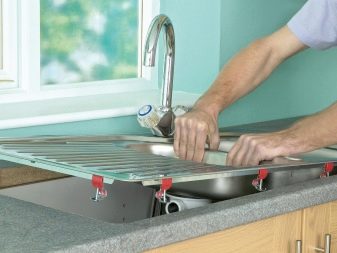
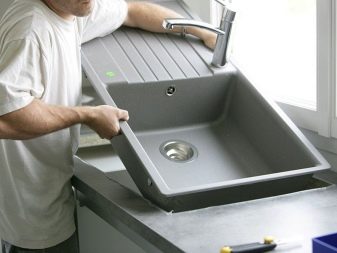
For information on how to embed a sink into the countertop with your own hands, see the next video.








